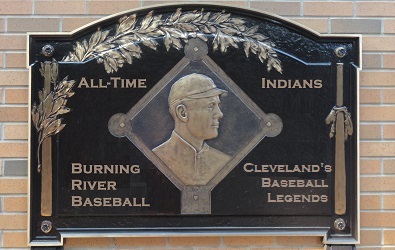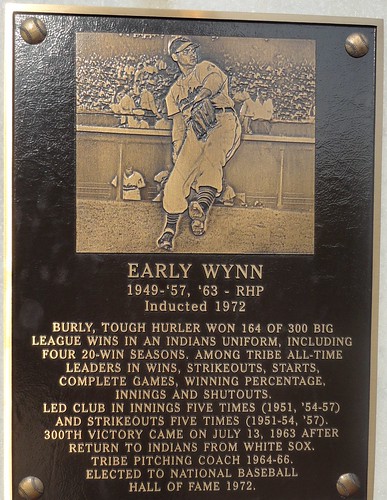| Name: | Early Wynn | Position: | Starting Pitcher | ||||||||||||
| Nick Name: | Gus | Number: | 24 | ||||||||||||
| Tribe Time: | 1949-1957, 1963 | DOB: | 01/06/1920 | ||||||||||||
| Accolades: | Hall of Fame (1972), 3 Time All-Star (1955-57), Top 5 MVP (1952) | ||||||||||||||
| Stats | W | L | W% | ERA | G | GS | CG | SHO | IP | H | ER | HR | BB | SO | WHIP |
| Best Season (1954) | 23 | 11 | .676 | 2.73 | 40 | 36 | 20 | 3 | 270.0 | 225 | 82 | 21 | 83 | 155 | 1.14 |
| Indians Career | 164 | 102 | .617 | 3.24 | 343 | 296 | 144 | 24 | 2,286.2 | 2,037 | 824 | 181 | 877 | 1,277 | 1.27 |
| Post Season | 0 | 1 | .000 | 3.86 | 1 | 1 | 0 | 0 | 7 | 4 | 3 | 1 | 2 | 5 | 0.86 |
The Indians in the mid-20th century were famous for their starting pitchers. So much so that Early Wynn, one of the greatest in franchise history, is often overlooked. Unlike Bob Feller and Mel Harder before him, Wynn didn’t play his entire career with the Indians and, unlike Bob Lemon (and Feller), he wasn’t part of a World Series winning rotation. Despite this, his career numbers with the team match up favorably with the best and when you include his years away from Cleveland, he was a 300 game winner who held a 3.54 ERA over 4,500 innings.
Wynn began his career in 1937 when he was signed by the Washington Senators and it took the 17 year old just two years to make his Major League debut. After an inauspicious debut, he would spend 1940 in the minors before breaking in for good in 1941. After three seasons in the regular rotation for Washington, Wynn joined the Army late in 1944 and missed all of 1945. Upon his return, mid-season in 1946, he would have two good seasons including his first all-star appearance in 1947, but after a poor year in 1948, he was traded to Cleveland in a great deal for the Indians that also saw them gain Mickey Vernon for Eddie Robinson, Joe Haynes and Ed Klieman.
Bill Veeck always had an eye for talent and, despite an ERA near six and 19 losses in 1948, Wynn would post a 4.15 ERA upon joining the Indians rotation in 1949 and lead the league with a 3.20 in 1950. While the Indians may have seemed to have a surplus of pitching, the emergence of Wynn in the early 1950’s was of the utmost importance. Feller was beginning his third decade in the game and, although he was only 31 in 1950, his poor performance in the 1948 postseason and 1949 had to bring his future into question. In addition, Gene Bearden, whose success as a rookie in 1948 made him look like a star, struggled so much in 1949 and early 1950 that he was designated for assignment and picked up by Washington.
With Wynn, however, the Indians had a solid starting four with Lemon, Feller and Mike Garcia around him. Despite being just a year and two months younger then Feller, Wynn had pitched significantly fewer innings and was just coming into his prime in his early 30’s. He would improve upon his 3.20 ERA in 1951 with a 3.02 mark, leading the league in games started and innings, finishing 16th in the MVP race.
As Feller would continue to fade, Wynn (along with Garcia and Lemon) would continue to shine. In 1952, he dropped that ERA to 2.90 and won 23 games, he second straight with at least 20 and a career high he would tie again, but never surpass. He also set a career mark in innings that year with 285.2 and finished fifth in MVP voting behind three Yankees and the ultimate winner, Philadelphia A’s Bobby Shantz. As a trio, each of Lemon, Garcia and Wynn finished with an ERA under 3.00 and won at least 22 games.
As a team, the Indians won 93 games in 1952 and finished in second to the Yankees, a common theme for the decade as they’d win at least 90 games each year from 1950 through 1955 and finish second to the Yankees each year from 1951 through 1956 except for 1954.
As good as the pitching had been in 1952, the offense would take center stage in 1953 with Al Rosen winning MVP. It was an off year for Wynn, who had an ERA of 3.93, but still won 17 games and pitched over 250 innings. The next season, both pitching staff and offense would put things together simultaneously as the Indians won 111 games, more than any other team previously in baseball history. While Wynn had been great prior, this is the season that put him on the road to Cooperstown as he lead the league in innings and wins (23 again) with a 2.73 ERA and a career best (to this point) 155 strike outs. He finished 6th in the MVP race that year behind three of his teammates, Minnie Minoso and the winner, Yogi Berra.
In the World Series again the Giants, the Indians were famously swept by Willie Mays and company, but Wynn was hardly to blame. His only start was in game two and he allowed just three runs in seven innings. The Indians could muster just a single run on an Al Smith home run, however, and the Indians were half way to their demise.
Despite having truly great seasons in 1943, 1944 and 1947 with Washington, then 1950 through 1952 with the Indians, it really was this 1954 campaign that earned Wynn fame and he would go to the next six All-Star games after going to just one in his first 14 seasons. In both 1955 and 1956 he held an ERA below 3.00 and finished in the top 20 of MVP voting. By 1955, Feller was no longer a starter and the upstart Herb Score replaced him in the rotation, winning Rookie of the Year. Wynn and Lemon each had excellent years as well, although Garcia was fading fast.
It appeared that Wynn may be the head of the rotation that ushered in the next generation of Indians pitchers, but Score’s debilitating injury in 1957 put an end to that hope and Wynn finally appeared to show his age with a 4.31 ERA after the greatest three run span of his career. Interestingly enough, Wynn increased his k-rate to 6.3 per nine in 1957, a career high, and struck out a league best 184, also a career high. While he didn’t have the ability to force weak contact that he had prior in his career, he was missing more bats then ever.
Given that he was 38 years old and coming off the worst season of his career, it makes sense that the Indians would give up on Wynn and he was traded to the White Sox along with Smith to bring back Minoso and acquire Fred Hatfield. Minoso would have two good years before being traded back to Chicago for Norm Cash, a deal that would have been great had they kept Cash.
Wynn would go on to pitch five seasons with the White Sox including a 22 win season in 1959 when he won the Cy Young and pitched three games in the World Series, losing his second and final attempt at a ring. Still pitching strong at the age of 40, Wynn made his final All-Star game in 1960 and finished with a 3.49 ERA and 6.0 K/9.
After two more seasons in Chicago, he was released and brought back to Cleveland to finish his career. At 43, Wynn wasn’t capable of handling a full time starter’s workload, but still was impressive with a 2.28 ERA in 20 appearances including five starts. This was part of the attempt by the front office to bring back the fanbase after Frank Lane devastated the team with trades in the late 1950’s. In addition to Wynn, Smith, Jim Perry, Larry Doby and Rocky Colavito were also brought back during the 1960’s after initially being traded away the previous decade.
Incredibly, Wynn pitched in four decades and thus, accumulated some impressive stats, enough to earn him enshrinement in the Hall of Fame in 1972, his fourth year on the ballot. As it stands, he is still seventh in Indians history in career innings pitched and remains in the top five in wins and strikeouts (tied for second with Bob Lemon). After his playing career, he went on to be a pitching coach for the Indians and the Twins. Following this, he worked as a broadcaster for Toronto and Chicago. He retired after the 1983 season and died in 1999 in Florida.
Add The Sports Daily to your Google News Feed!

